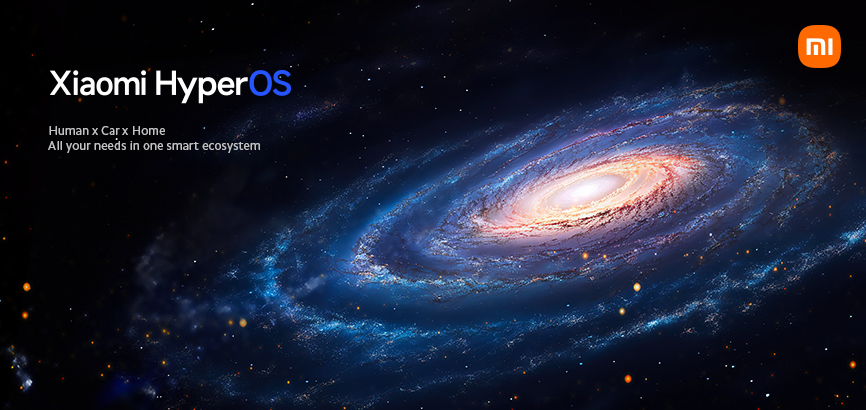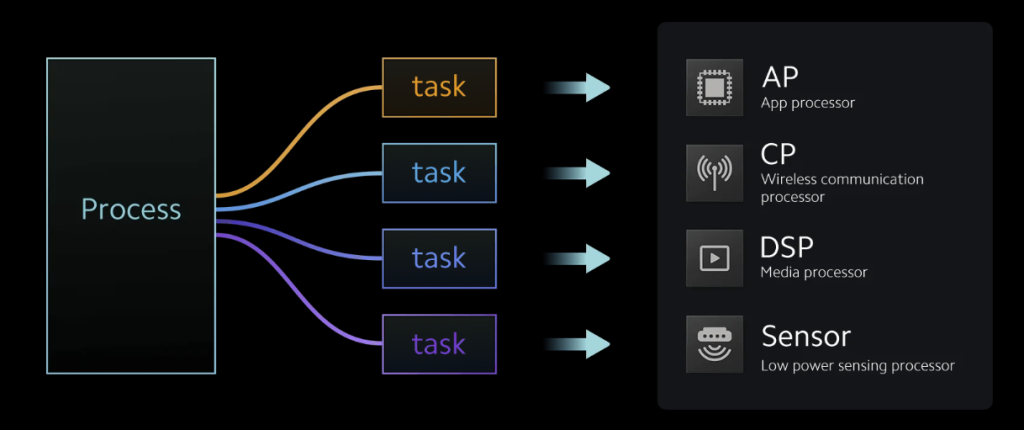Back in 2017, Xiaomi began working on a new operating system (OS) designed to cope with the problems caused by different device operating systems and problems with interoperability in the Internet of Things (IoT). This OS was developed to bring all Xiaomi ecosystem devices together, ensuring top performance, a consistent user experience, and easy connectivity within the Xiaomi ecosystem.
In 2023, they introduced it as HyperOS.

What is HyperOS from Xiaomi?
HyperOS is an operating system that is focused on people and was made for a smart ecosystem that includes people, cars, and homes. It advocates complete refactoring to make the most of the hardware capabilities of devices, ensuring smooth performance and effective resource scheduling. HyperOS lets powerful devices do computing faster, gives important tasks quick scheduling, and lets lightweight devices perform flexible distributed computing.

The operating system employs an extremely lightweight file system for continuous performance and reduced storage occupancy. It also enhances OTA upgrades and boasts superior heterogeneous compatibility, supporting various file systems and processor platforms.
HyperOS focuses on an “Alive Design Philosophy” with comfortable, fluid, and diverse graphics subsystem restructuring, enabling high-quality rendering and dynamic visuals. It also focuses on end-to-end security, featuring hardware-level protection, self-developed TEE (Trusted Execution Environment), and strengthened system app security.
When was HyperOS released?
HyperOS was first announced in China with the Xiaomi 14 series in October 2023.
How is HyperOS different from MIUI?
HyperOS differs significantly from MIUI as it’s built on AOSP (Android Open Source Project) and Xiaomi’s Vela system, in contrast to MIUI’s reliance on Google’s Android. This change allows it to efficiently run on devices with varying RAM sizes and grants Xiaomi more flexibility in selecting features, free from Google’s service constraints.
Android 14-based HyperOS offers improved performance, faster boot times, and smooth background operations. It’s compatible with a wide range of Xiaomi ecosystem devices, such as smartphones, watches, and TVs, making it a promising choice for those seeking innovative features.
What are the new features of HyperOS?
HyperOS introduces a suite of innovative features:
User Interface Enhancements:
Design Philosophy
HyperOS maintains a similar design to MIUI but offers a more refined and clutter-free interface. It stands out by having fewer pre-installed applications and less bloatware, resulting in a cleaner and more streamlined user experience.
Animation Quality
HyperOS boasts smoother, more refined animations, offering a sophisticated touch compared to MIUI’s more dynamic and whimsical style.
Customization Approach
HyperOS introduces numerous customization options within both system settings and individual apps. For instance, users can now easily extract a portion of an image by tapping on it, allowing them to use it as a sticker or simply copy it.
Additionally, when accessing WiFi or Bluetooth settings via the command center, HyperOS displays a separate tab presenting available devices, mirroring the user-friendly approach seen in iOS. Now the Weather app provides not only essential weather information but also conveys the real feel of the current conditions outside.

HyperOS also introduces a Dynamic Island-like animation for phone charging. It elevates multitasking with improved floating window and split-screen functionalities. Additionally, the lock screen is more customizable, offering various styles and effects for a personalized user experience.
Performance Upgrades:
Storage Efficiency
HyperOS is remarkably more storage-efficient than MIUI, using about 30% less space than MIUI 14, which contributes to a smoother and more fluid performance.

Enhanced RAM Management
HyperOS improves RAM utilization, allowing applications to remain active longer and reducing the frequency of app reloads.
Advanced System Operations
HyperOS has optimized resource allocation and power management, potentially extending battery life.
AI-Driven Features:
HyperOS integrates cutting-edge AI capabilities, such as AI-enhanced text recognition from images, advanced speech generation, and intelligent image search.
The operating system enhances device interconnectivity through Xiaomi’s HyperConnect and Hypermind technologies, augmenting the functionality of smartphones, smartwatches, and smart home devices within the Xiaomi ecosystem.
HyperOS supports seamless device switching, remote data, and app access, and offers faster app loading times.
Which Devices Will Get HyperOS Update?
Here is a list of Xiaomi and Redmi smartphones eligible for the HyperOS update:
- Xiaomi 11 series, 11T series, 11X series, 11i series, 12 series, 12T series, 12S series, and 13 series are expected to receive the update in the first quarter of 2024
- Xiaomi 13T series started receiving the update in January 2024
- Xiaomi 14 series comes pre-installed with HyperOS
- Xiaomi Mix Fold series and Civi series are expected to get the update in the first quarter of 2024
- Xiaomi Pad 6 series started receiving the update in January 2024, while the Pad 5 series will get it in the first quarter of 2024
- Redmi K40 series, K50 series, K60 series, and 11 series are set to receive the update in the first quarter of 2024
- Redmi 11 Prime, 12 series will also get the update in the first quarter of 2024
- Surprisingly Redmi 12C started getting the update in January 2024
- Redmi Note 13 series is expected to receive the update in the first quarter of 2024
- Redmi Pad and Pad SE will get the update in the first quarter of 2024
- POCO M6 Pro 5G will also get the update in the first quarter of 2024
- POCO C51 and C55 will receive the update in the first quarter of 2024, while various POCO X, F, and M series devices are expected to get the update in the same timeframe
- POCO F5 has already got the update in January 2024
Update: Official update timeline for the Indian smartphones:
- Xiaomi 13 Pro, Pad 6, Redmi 12 5G, Redmi 12C, Redmi 11 Prime, and Redmi Pad have received the update
- Xiaomi 12 Pro, Redmi Note 12 5G, Redmi Note 12 Pro 5G, Redmi Note 12 Pro+ 5G will receive the update in March in India
- Mi 11 Ultra, Xiaomi 11T Pro, Mi 11X, 11i HyperCharge, Mi 11 Lite, 11i, Mi 10, Pad 5, Redmi K50i, Redmi 13C series, Redmi 12, Redmi 11 Prime 5G, Redmi Note 11 series will receive the update in Q2 2024
Since there are a lot of devices getting this update we might miss one or two. If your device is not mentioned here I will ask you to research through our news section to get more info.
FAQs: Your Burning Questions Answered
What is HyperOS?
HyperOS is Xiaomi’s latest operating system, based on a fusion of Linux and Xiaomi Vela, featuring a compact firmware size and designed for a human-centric, smart ecosystem.
How do I get HyperOS?
Currently, availability is limited to specific devices with future OTA updates planned for eligible models.
When HyperOS is released in India?
Xiaomi has started to roll out HyperOS in India starting from January 2024. POCO F5 is the first device to receive the update.
Is HyperOS better than MIUI?
It’s subjective. HyperOS prioritizes clean design and performance, while MIUI offers a wider range of features and customizations. Ultimately, the choice depends on your preferences.
Will older Xiaomi phones get HyperOS?
Xiaomi plans to release HyperOS based on Android 13, for older Xiaomi devices in the second quarter of 2024. However, it’s important to note that these devices may not have all the features of the full HyperOS package.
RELATED:
- Alleged Xiaomi Pad 6S Pro Details Leaked, Could Be A Half-Generation Upgrade
- Xiaomi BE 3600 WiFi 7 router goes on sale in China for 249 yuan ($35)
- Get Redmi K70 Pro for discounted price of $499
- Xiaomi Band 8 Genshin Impact custom edion get a huge discount
- Best of CES 2024 – Products that stood out this year!






